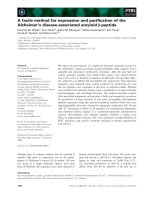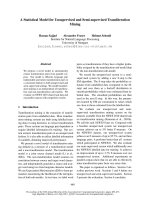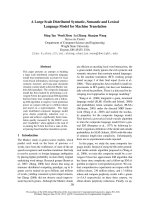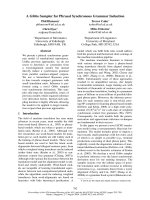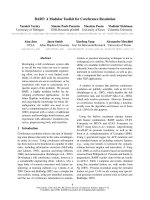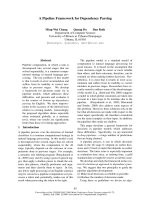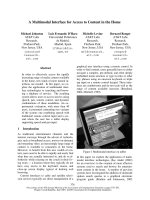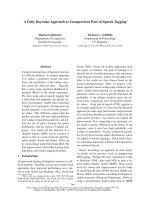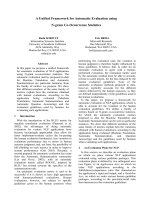Báo cáo khoa học: "A Word-Order Database for Testing Computational Models of Language Acquisition" docx
Bạn đang xem bản rút gọn của tài liệu. Xem và tải ngay bản đầy đủ của tài liệu tại đây (200.73 KB, 8 trang )
A Word-Order Database for Testing
Computational Models of Language Acquisition
William Gregory Sakas
Department of Computer Science
PhD Programs in Linguistics and Computer Science
Hunter College and The Graduate Center
City University of New York
Abstract
An investment of effort over the last two
years has begun to produce a wealth of
data concerning computational psycholin-
guistic models of syntax acquisition. The
data is generated by running simulations
on a recently completed database of word
order patterns from over 3,000 abstract
languages. This article presents the design
of the database which contains sentence
patterns, grammars and derivations that
can be used to test acquisition models from
widely divergent paradigms. The domain
is generated from grammars that are lin-
guistically motivated by current syntactic
theory and the sentence patterns have been
validated as psychologically/developmen-
tally plausible by checking their frequency
of occurrence in corpora of child-directed
speech. A small case-study simulation is
also presented.
1 Introduction
The exact process by which a child acquires the
grammar of his or her native language is one of the
most beguiling open problems of cognitive
science. There has been recent interest in computer
simulation of the acquisition process and the
interrelationship between such models and linguis-
tic and psycholinguistic theory. The hope is that
through computational study, certain bounds can
be established which may be brought to bear on
pivotal issues in developmental psycholinguistics.
Simulation research is a significant departure
from standard learnability models that provide
results through formal proof (e.g., Bertolo, 2001;
Gold, 1967; Jain et al., 1999; Niyogi, 1998; Niyogi
& Berwick, 1996; Pinker, 1979; Wexler & Culi-
cover, 1980, among many others). Although
research in learnability theory is valuable and
ongoing, there are several disadvantages to formal
modeling of language acquisition:
• Certain proofs may involve impractically many
steps for large language domains (e.g. those
involving Markov methods).
• Certain paradigms are too complex to readily
lend themselves to deductive study (e.g. con-
nectionist models).
1
• Simulations provide data on intermediate stages
whereas formal proofs typically prove whether
a domain is (or more often is not) learnable a
priori to specific trials.
• Proofs generally require simplifying assump-
tions which are often distant from natural lan-
guage.
However, simulation studies are not without
disadvantages and limitations. Most notable
perhaps, is that out of practicality, simulations are
typically carried out on small, severely circum-
scribed domains – usually just large enough to
allow the researcher to hone in on how a particular
model (e.g. a connectionist network or a principles
& parameters learner) handles a few grammatical
features (e.g. long-distance agreement and/or
topicalization) often, though not always, in a single
language. So although there have been many
successful studies that demonstrate how one
algorithm or another is able to acquire some aspect
of grammatical structure, there is little doubt that
the question of what mechanism children actually
employ during the acquisition process is still open.
This paper reports the development of a large,
multilingual database of sentence patterns, gram-
1
Although see Niyogi, 1998 for some insight.
mars and derivations that may be used to test
computational models of syntax acquisition from
widely divergent paradigms. The domain is
generated from grammars that are linguistically
motivated by current syntactic theory and the
sentence patterns have been validated as psycho-
logically/developmentally plausible by checking
their frequency of occurrence in corpora of child-
directed speech. We report here the structure of the
domain, its interface and a case-study that demon-
strates how the domain has been used to test the
feasibility of several different acquisition strate-
gies.
The domain is currently publicly available on
the web via http://146.95.2.133 and it is our hope
that it will prove to be a valuable resource for
investigators interested in computational models of
natural language acquisition.
2 The Language Domain Database
The focus of the language domain database,
(hereafter LDD), is to make readily available the
different word order patterns that children are
typically exposed to, together with all possible
syntactic derivations of each pattern. The patterns
and their derivations are generated from a large
battery of grammars that incorporate many features
from the domain of natural language.
At this point the multilingual language domain
contains sentence patterns and their derivations
generated from 3,072 abstract grammars. The
patterns encode sentences in terms of tokens
denoting the grammatical roles of words and
complex phrases, e.g., subject (S), direct object
(O1), indirect object (O2), main verb (V), auxiliary
verb (Aux), adverb (Adv), preposition (P), etc. An
example pattern is S Aux V O1 which corresponds
to the English sentence: The little girl can make a
paper airplane. There are also tokens for topic and
question markers for use when a grammar specifies
overt topicalization or question marking.
Declarative sentences, imperative sentences,
negations and questions are represented within the
LDD, as is prepositional movement/stranding
(pied-piping), null subjects, null topics, topicaliza-
tion and several types of movement.
Although more work needs to be done, a first
round study of actual child-directed sentences from
the CHILDES corpus (MacWhinney, 1995)
indicates that our patterns capture many sentential
word orders that children typically encounter in the
period from 1-1/2 to 2-1/2 years; the period
generally accepted by psycholinguists to be when
children establish the correct word order of their
native language. For example, although the LDD is
currently limited to degree-0 (i.e. no embedding)
and does not contain DP-internal structure, after
examining by hand, several thousand sentences
from corpora in the CHILDES database in five
languages (English, German, Italian, Japanese and
Russian), we found that approximately 85% are
degree-0 and an approximate 10 out of 11 have no
internal DP structure.
Adopting the principles and parameters (P&P)
hypothesis (Chomsky, 1981) as the underlying
framework, we implemented an application that
generated patterns and derivations given the
following points of variation between languages:
1. Affix Hopping 2. Comp Initial/Final
3. I to C Movement 4. Null Subject
5. Null Topic 6. Obligatory Topic
7. Object Final/Initial 8. Pied Piping
9. Question Inversion 10. Subject Initial/Final
11. Topic Marking 12. V to I Movement
13. Obligatory Wh movement
The patterns have fully specified X-bar struc-
ture, and movement is implemented as HPSG local
dependencies. Pattern production is generated top-
down via rules applied at each subtree level.
Subtree levels include: CP, C', IP, I', NegP, Neg',
VP, V' and PP. After the rules are applied, the
subtrees are fully specified in terms of node
categories, syntactic feature values and constituent
order. The subtrees are then combined by a simple
unification process and syntactic features are
percolated down. In particular, movement chains
are represented as traditional “slash” features
which are passed (locally) from parent to daughter;
when unification is complete, there is a trace at the
bottom of each slash-feature path. Other features
include +/-NULL for non-audible tokens (e.g.
S[+NULL] represents a null subject pro), +TOPIC
to represent a topicalized token, +WH to represent
“who”, “what”, etc. (or “qui”, “que” if one pre-
fers), +/-FIN to mark if a verb is tensed or not and
the illocutionary (ILLOC) features Q, DEC, IMP
for questions, declaratives and imperatives respec-
tively.
Although further detail is beyond the scope of
this paper, those interested may refer to Fodor et
al. (2003) which resides on the LDD website.
It is important to note that the domain is suit-
able for many paradigms beyond the P&P frame-
work. For example the context-free rules (with
local dependencies) could be easily extracted and
used to test probabilistic CFG learning in a
multilingual domain. Likewise the patterns,
without their derivations, could be used as input to
statistical/connectionist models which eschew
traditional (generative) structure altogether and
search for regularity in the left-to-right strings of
tokens that makeup the learner's input stream. Or,
the patterns could help bootstrap the creation of a
domain that might be used to test particular types
of lexical learning by using the patterns as tem-
plates where tokens may be instantiated with actual
words from a lexicon of interest to the investigator.
The point is that although a particular grammar
formalism was used to generate the patterns, the
patterns are valid independently of the formalism
that was in play during generation.
2
To be sure, similar domains have been con-
structed. The relationship between the LDD and
other artificial domains is summarized in Table 1.
In designing the LDD, we chose to include
syntactic phenomena which:
i) occur in a relatively high proportion of the
known natural languages;
2
If this is the case, one might ask: Why bother with a
grammar formalism at all; why not use actual child-directed
speech as input instead of artificially generated patterns?
Although this approach has proved workable for several types
of non-generative acquisition models, a generative (or hybrid)
learner is faced with the task of selecting the rules or
parameter values that generate the linguistic environment
being encountered by the learner. In order to simulate this,
there must be some grammatical structure incorporated into
the experimental design that serves as the target the learner
must acquire. Constructing a viable grammar and a parser with
coverage over a multilingual domain of real child-directed
speech is a daunting proposition. Even building a parser to
parse a single language of child-directed speech turns out to be
extremely difficult. See, for example, Sagae, Lavie, &
MacWhinney (2001), which discusses an impressive number
of practical difficulties encountered while attempting to build
a parser that could cope with the EVE corpus; one the cleanest
transcriptions in the CHILDES database. By abstracting away
from actual child-directed speech, we were able to build a
pattern generator and include the pattern derivations in the
database for retrieval during simulation runs, effectively
sidestepping the need to build an online multilingual parser.
ii) are frequently exemplified in speech di-
rected to 2-year-olds;
iii) pose potential learning problems (e.g. cross-
language ambiguity) for which theoretical
solutions are needed;
iv) have been a focus of linguistic and/or psy-
cholinguistic research;
v) have a syntactic analysis that is broadly
agreed on.
As a result the following have been included:
• By criteria (i) and (ii): negation, non-
declarative sentences (questions, impera-
tives).
• By criterion (iv): null subject parameter
(Hyams 1986 and since).
• By criterion (iv): affix-hopping (though not
widespread in natural languages).
• By criterion (v): no scrambling yet.
There are several phenomena that the LDD
does not yet include:
• No verb subcategorization.
• No interface with LF (cf. Briscoe 2000;
Villavicencio 2000).
• No discourse contexts to license sentence
fragments (e.g., DP or PP fragments).
• No XP-internal structure yet (except PP = P
+ O3, with piping or stranding).
• No Linear Correspondence Axiom (Kayne
1994).
• No feature checking as implementation of
movement parameters (Chomsky 1995).
Table 1: A history of abstract domains for word-
order acquisition modeling.
#
parame
ters
#
lan-
guages
Tree
struc-
ture?
Language
properties
Gibson &
Wexler
(1994)
3 8
Not fully
specified
Word order, V2
Bertolo et.
al (1997b)
7
64
distinct
Yes
G&W + V-raising to
Agr, T; deg-2
Kohl (1999)
based on
Bertolo
12 2,304 Partial
Bertolo et al.
(1997b) +
scrambling
Sakas &
Nishimoto
(2002)
4 16 Yes
G&W + null
subject/topic
LDD 13 3,072 Yes
S&N + wh-movt +
imperatives +aux
inversion, etc.
The LDD on the web: The two primary purposes
of the web-interface are to allow the user to
interactively peruse the patterns and the derivations
that the LDD contains and to download raw data
for the user to work with locally.
Users are asked to register before using the
LDD online. The user ID is typically an email
address, although no validity checking is carried
out. The benefit of entering a valid email address is
simply to have the ability to recover a forgotten
password, otherwise a user can have full access
anonymously.
The interface has three primary areas: Gram-
mar Selection, Sentence Selection and Data
Download. First a user has to specify, on the
Grammar Selection page, which settings of the 13
parameters are of interest and save those settings as
an available grammar. A user may specify multiple
grammars. Then in the sentence selection page a
user may peruse sentences and their derivations.
On this page a user may annotate the patterns and
derivations however he or she wishes. All grammar
settings and annotations are saved and available
the next time the user logs on. Finally on the Data
Download page, users may download data so that
they can use the patterns and derivations offline.
The derivations are stored as bracketed strings
representing tree structure. These are practically
indecipherable by human users. E.g.:
(CP[ILLOC Q][+FIN][+WH] "Adv[+TOPIC]" (Cbar[ILLOC
Q] [+FIN][+WH][SLASH Adv](C[ILLOC Q][+FIN] "KA" )
(IP[ILLOC Q][+FIN][+WH][SLASH Adv]"S" (Ibar[ILLOC
Q][+FIN][+WH][SLASH Adv](I[ILLOC
Q][+FIN]"Aux[+FIN]")(NegP[+WH] [SLASH
Adv](NegBar[+WH][SLASH Adv](Neg "NOT")
(VP[+WH][SLASH Adv](Vbar[+WH][SLASH
Adv](V"Verb")"O1" "O2" (PP[+WH] "P" "O3[+WH]"
)"Adv[+NULL][SLASH Adv]"))))))))
To be readable, the derivations are displayed
graphically as tree structures. Towards this end we
have utilized a set of publicly available LaTex
macros: QTree (Siskind & Dimitriadis, [online]). A
server-side script parses the bracketed structures
into the proper QTree/LaTex format from which a
pdf file is generated and subsequently sent to the
user's client application.
Even with the graphical display, a simple sen-
tence-by-sentence presentation is untenable given
the large amount of linguistic data contained in the
database. The Sentence Selection area allows users
to access the data filtered by sentence type and/or
by grammar features (e.g. all sentences that have
obligatory-wh movement and contain a preposi-
tional phrase), as well as by the user’s defined
grammar(s) (all sentences that are "Italian-like").
On the Data Download page, users may filter
sentences as on the Sentence Selection page and
download sentences in a tab-delimited format. The
entire LDD may also be downloaded – approxi-
mately 17 MB compressed, 600 MB as a raw ascii
file.
3 A Case Study: Evaluating the efficiency
of parameter-setting acquisition models.
We have recently run experiments of seven
parameter-setting (P&P) models of acquisition on
the domain. What follows is a brief discussion of
the algorithms and the results of the experiments.
We note in particular where results stemming from
work with the LDD lead to conclusions that differ
from those previously reported. We stress that this
is not intended as a comprehensive study of
parameter-setting algorithms or acquisition
algorithms in general. There is a large number of
models that are omitted; some of which are targets
of current investigation. Rather, we present the
study as an example of how the LDD could be
effectively utilized.
In the discussion that follows we will use the
terms “pattern”, “sentence” and “input” inter-
changeably to mean a left-to-right string of tokens
drawn from the LDD without its derivation.
3.1 A Measure of Feasibility
As a simple example of a learning strategy and
of our simulation approach, consider a domain of 4
binary parameters and a memoryless learner
3
which blindly guesses how all 4 parameters should
be set upon encountering an input sentence. Since
there are 4 parameters, there are 16 possible
combinations of parameter settings. i.e., 16
different grammars. Assuming that each of the 16
grammars is equally likely to be guessed, the
learner will consume, on average, 16 sentences
before achieving the target grammar. This is one
measure of a model’s efficiency or feasibility.
3
By “memoryless” we mean that the learner processes inputs
one at a time without keeping a history of encountered inputs
or past learning events.
However, when modeling natural language
acquisition, since practically all human learners
attain the target grammar, the average number of
expected inputs is a less informative statistic than
the expected number of inputs required for, say,
99% of all simulation trials to succeed. For our
blind-guess learner, this number is 72.
4
We will
use this 99-percentile feasibility measure for most
discussion that follows, but also include the
average number of inputs for completeness.
3.2 The Simulations
In all experiments:
• The learners are memoryless.
• The language input sample presented to the
learner consists of only grammatical sentences
generated by the target grammar.
• For each learner, 1000 trials were run for each
of the 3,072 target languages in the LDD.
• At any point during the acquisition process,
each sentence of the target grammar is equally
likely to be presented to the learner.
Subset Avoidance and Other Local Maxima:
Depending on the algorithm, it may be the case
that a learner will never be motivated to change its
current hypothesis (G
curr
), and hence be unable to
ultimately achieve the target grammar (G
targ
). For
example, most error-driven learners will be trapped
if G
curr
generates a language that is a superset of
the language generated by G
targ
. There is a wealth
of learnability literature that addresses local
maxima and their ramifications.
5
However, since
our study’s focus is on feasibility (rather than on
whether a domain is learnable given a particular
algorithm), we posit a built-in avoidance mecha-
nism, such as the subset principle and/or default
values that preclude local maxima; hence, we set
aside trials where a local maximum ensues.
4
The average and 99-percentile figures (16 and 72) in this
section are easily derived from the fact that input consumption
follows a hypergeometric distribution.
5
Discussion of the problem of subset relationships among
languages starts with Gold’s (1967) seminal paper and is
discussed in Berwick (1985) and Wexler & Manzini (1987).
Detailed accounts of the types of local maxima that the learner
might encounter in a domain similar to the one we employ are
given in Frank & Kapur (1996), Gibson & Wexler (1994), and
Niyogi & Berwick (1996).
3.3 The Learners' strategies
In all cases the learner is error-driven: if G
curr
can
parse the current input pattern, retain it.
6
The following refers to what the learner does
when G
curr
fails on the current input.
• Error-driven, blind-guess (EDBG): adopt any
grammar from the domain chosen at random –
not psychologically plausible, it serves as our
baseline.
• TLA (Gibson & Wexler, 1994): change any one
parameter value of those that make up G
curr
.
Call this new grammar G
new
. If G
new
can parse
the current input, adopt it. Otherwise, retain
G
curr
.
• Non-Greedy TLA (Niyogi & Berwick, 1996):
change any one parameter value of those that
make up G
curr
. Adopt it. (I.e. there is no testing
of the new grammar against the current input).
• Non-SVC TLA (Niyogi & Berwick, 1996): try
any grammar in the domain. Adopt it only in the
event that it can parse the current input.
• Guessing STL (Fodor, 1998a): Perform a
structural parse of the current input. If a choice
point is encountered, chose an alternative based
on one of the following and then set parameter
values based on the final parse tree:
• STL Random Choice (RC) – randomly pick a
parsing alternative.
• Minimal Chain (MC) – pick the choice that
obeys the Minimal Chain Principle (De Vin-
cenzi, 1991), i.e., avoid positing movement
transformations if possible.
• Local Attachment/Late Closure (LAC) –pick
the choice that attaches the new word to the
current constituent (Frazier, 1978).
The EDBG learner is our first learner of inter-
est. It is easy to show that the average and 99%
scores increase exponentially in the number of
parameters and syntactic research has proposed
more than 100 (e.g. Cinque, 1999). Clearly, human
learners do not employ a strategy that performs as
poorly as this. Results will serve as a baseline to
compare against other models.
6
We intend for a “can-parse/can’t-parse outcome” to be
equivalent to the result from a language membership test. If
the current input sentence is one of the set of sentences
generated by G
curr
, can-parse is engendered; if not, can’t-
parse.
99% Average
EDBG 16,663 3,589
Table 2: EDBG, # of sentences consumed
The TLA: The TLA incorporates two search
heuristics: the Single Value Constraint (SVC) and
Greediness. In the event that G
curr
cannot parse the
current input sentence s, the TLA attempts a
second parse with a randomly chosen new gram-
mar, G
new
, that differs from G
curr
by exactly one
parameter value (SVC). If G
new
can parse s, G
new
becomes the new G
curr
otherwise G
new
is rejected as
a hypothesis (Greediness). Following Berwick and
Niyogi (1996), we also ran simulations on two
variants of the TLA – one with the Greediness
heuristic but without the SVC (TLA minus SVC,
TLA–SVC) and one with the SVC but without
Greediness (TLA minus Greediness, TLA–Greed).
The TLA has become a seminal model and has
been extensively studied (cf. Bertolo, 2001 and
references therein; Berwick & Niyogi, 1996; Frank
& Kapur, 1996; Sakas, 2000; among others). The
results from the TLA variants operating in the
LDD are presented in Table 3.
99% Average
TLA-SVC 67,896 11,273
TLA-Greed 19,181 4,110
TLA 16,990 961
Table 3: TLA variants, # of sentences consumed
Particularly interesting is that contrary to results
reported by Niyogi & Berwick (1996) and Sakas &
Nishimoto (2002), the SVC and Greediness
constraints do help the learner achieve the target in
the LDD. The previous research was based on
simulations run on much smaller 9 and 16 lan-
guage domains (see Table 1). It would seem that
the local hill-climbing search strategies employed
by the TLA do improve learning efficiency in the
LDD. However, even at best, the TLA performs
less well than the blind guess learner. We conjec-
ture that this fact probably rules out the TLA as a
viable model of human language acquisition.
The STL: Fodor’s Structural Triggers Learner
(STL) makes greater use of the parser than the
TLA. A key feature of the model is that parameter
values are not simply the standardly presumed 0 or
1, but rather bits of tree structure or treelets. Thus,
a grammar, in the STL sense, is a collection of
treelets rather than a collection of 1's and 0's. The
STL is error-driven. If G
curr
cannot license s, new
treelets will be utilized to achieve a successful
parse.
7
Treelets are applied in the same way as any
“normal” grammar rule, so no unusual parsing
activity is necessary. The STL hypothesizes
grammars by adding parameter value treelets to
G
curr
when they contribute to a successful parse.
The basic algorithm for all STL variants is:
1. If G
curr
can parse the current input sentence,
retain the treelets that make up G
curr
.
2. Otherwise, parse the sentence making use of
any or all parametric treelets available and
adopt those treelets that contribute to a suc-
cessful parse. We call this parametric de-
coding.
Because the STL can decode inputs into their
parametric signatures, it stands apart from other
acquisition models in that it can detect when an
input sentence is parametrically ambiguous.
During a parse of s, if more than one treelet could
be used by the parser (i.e., a choice point is
encountered), then s is parametrically ambiguous.
The TLA variants do not have this capacity
because they rely only on a can-parse/can’t-parse
outcome and do not have access to the on-line
operations of the parser. Originally, the ability to
detect ambiguity was employed in two variations
of the STL: the strong STL (SSTL) and the weak
STL.
The SSTL executes a full parallel parse of each
input sentence and adopts only those treelets
(parameter values) that are present in all the
generated parse trees. This would seem to make
the SSTL an extremely powerful, albeit psycho-
logically implausible, learner.
8
However, this is not
necessarily the case. The SSTL needs some
unambiguity to be present in the structures derived
from the sentences of the target language. For
example, there may not be a single input generated
by G
targ
that when parsed yields an unambiguous
treelet for a particular parameter.
7
In addition to the treelets, UG principles are also available
for parsing, as they are in the other models discussed above.
8
It is important to note that Fodor (1998a) does not put forth
the strong STL as a psychologically plausible model. Rather, it
is intended to demonstrate the potential effectiveness of
parametric decoding.
Unlike the SSTL, the weak STL executes a
psychologically plausible left-to-right serial
(deterministic) parse. One variant of the weak
STL, the waiting STL (WSTL), deals with ambigu-
ous inputs abiding by the heuristic: Don’t learn
from sentences that contain a choice point. These
sentences are simply discarded for the purposes of
learning. This is not to imply that children do not
parse ambiguous sentences they hear, but only that
they set no parameters if the current evidence is
ambiguous.
As with the TLA, these STL variants have been
studied from a mathematical perspective (Bertolo
et al., 1997a; Sakas, 2000). Mathematical analyses
point to the fact that the strong and weak STL are
extremely efficient learners in conducive domains
with some unambiguous inputs but may become
paralyzed in domains with high degrees of ambigu-
ity. These mathematical analyses among other
considerations spurred a new class of weak STL
variants which we informally call the guessing STL
family.
The basic idea behind the guessing STL models
is that there is some information available even in
sentences that are ambiguous, and some strategy
that can exploit that information. We incorporate
three different heuristics into the original STL
paradigm, the RC, MC and LAC heuristics
described above.
Although the MC and LAC heuristics are not
stochastic, we regard them as “guessing” heuristics
because, unlike the WSTL, a learner cannot be
certain that the parametric treelets obtained from a
parse guided by MC and LAC are correct for the
target. These heuristics are based on well-
established human parsing strategies. Interestingly,
the difference in performance between the three
variants is slight. Although we have just begun to
look at this data in detail, one reason may be that
the typical types of problems these parsing
strategies address are not included in the LDD (e.g.
relative clause attachment ambiguity). Still, the
STL variants perform the most efficiently of the
strategies presented in this small study (approxi-
mately a 100-fold improvement over the TLA).
Certainly this is due to the STL's ability to perform
parametric decoding. See Fodor (1998b) and Sakas
& Fodor (2001) for detailed discussion about the
power of decoding when applied to the acquisition
process.
Guessing
STL
99% Average
RC 1,486 166
MC 1,412 160
LAC 1,923 197
Table 4: guessing STL family, # of sen-
tences consumed
4 Conclusion and future work
The thrust of our current research is directed at
collecting data for a comprehensive, comparative
study of psycho-computational models of syntax
acquisition. To support this endeavor, we have
developed the Language Domain Database – a
publicly available test-bed for studying acquisition
models from diverse paradigms.
Mathematical analysis has shown that learners
are extremely sensitive to various distributions in
the input stream (Niyogi & Berwick, 1996; Sakas,
2000, 2003). Approaches that thrive in one domain
may dramatically flounder in others. So, whether a
particular computational model is successful as a
model of natural language acquisition is ultimately
an empirical issue and depends on the exact
conditions under which the model performs well
and the extent to which those favorable conditions
are in line with the facts of human language. The
LDD is a useful tool that can be used within such
an empirical research program.
Future work: Though the LDD has been vali-
dated against CHILDES data in certain respects,
we intend to extend this work by adding distribu-
tions to the LDD that correspond to actual distribu-
tions of child-directed speech. For example, what
percentage of utterances, in child-directed Japa-
nese, contain pro-drop? object-drop? How often in
English does the pattern: S[+WH] aux Verb O1
occur and at what periods of a child's develop-
ment? We believe that these distributions will shed
some light on many of the complex subtleties
involved in ambiguity disambiguation and the role
of nondeterminism and statistics in the language
acquisition process. This is proving to be a
formidable, yet surmountable task; one that we are
just beginning to tackle.
Acknowledgements
This paper reports work done in part with other
members of CUNY-CoLAG (CUNY's Computa-
tional Language Acquisition Group) including
Janet Dean Fodor, Virginia Teller, Eiji Nishimoto,
Aaron Harnley, Yana Melnikova, Erika Troseth,
Carrie Crowther, Atsu Inoue, Yukiko Koizumi,
Lisa Resig-Ferrazzano, and Tanya Viger. Also
thanks to Charles Yang for much useful discussion,
and valuable comments from the anonymous
reviewers. This research was funded by PSC-
CUNY Grant #63387-00-32 and CUNY Collabora-
tive Grant #92902-00-07.
References
Bertolo, S. (Ed.) (2001). Language Acquisition and
Learnability. Cambridge, UK: Cambridge University
Press.
Bertolo, S., Broihier, K., Gibson, E., & Wexler, K.
(1997a). Characterizing learnability conditions for
cue-based learners in parametric language systems.
Proceedings of the Fifth Meeting on Mathematics of
Language.
Bertolo, S., Broihier, K., Gibson, E., and Wexler, K.
(1997b) Cue-based learners in parametric language
systems: Application of general results to a recently
proposed learning algorithm based on unambiguous
'superparsing'. In M. G. Shafto and P. Langley (eds.)
the Cognitive Science Society, Mahwah NJ: Law-
rence Erlbaum Associates.
Berwick, R. C., & Niyogi, P. (1996). Learning from
triggers. Linguistic Inquiry, 27 (4), 605-622.
Briscoe, T. (2000). Grammatical acquisition: Inductive
bias and coevolution of language and the language
acquisition device. Language, 76 (2), 245-296.
Chomsky, N. (1981) Lectures on Government and
Binding, Dordrecht: Foris Publications.
Chomsky, N. (1995) The Minimalist Program. Cam-
bridge MA: MIT Press.
Cinque, G. (1999) Adverbs and Functional Heads.
Oxford Oxford, UK:University Press, Oxford, UK.
Fodor, J. D. (1998a) Unambiguous triggers, Linguistic
Inquiry 29.1, 1-36.
Fodor, J. D. (1998b) Parsing to learn. Journal of
Psycholinguistic Research 27.3, 339-374.
Fodor, J.D., Melnikova, Y. & Troseth, E. (2002) A
structurally defined language domain for testing
syntax acquisition models. Technical Report. CUNY
Graduate Center.
Gibson, E. and Wexler, K. (1994) Triggers. Linguistic
Inquiry 25, 407-454.
Gold, E. M. (1967) Language identification in the limit.
Information and Control 10, 447-474.
Hyams, N. (1986) Language Acquisition and the Theory
of Parameters. Dordrecht: Reidel.
Jain, S., E. Martin, D. Osherson, J. Royer, and A.
Sharma. (1991) Systems That Learn. 2nd ed. Cam-
bridge, MA: MIT Press.
Kayne, R. S. (1994) The Antisymmetry of Syntax.
Cambridge MA: MIT Press.
Kohl, K.T. (1999) An Analysis of Finite Parameter
Learning in Linguistic Spaces. Master’s Thesis, MIT.
MacWhinney, B. (1995) The CHILDES Project: Tools
for Analyzing Talk. (2
nd
ed.) Hillsdale, NJ: Lawrence
Erlbaum Associates.
Niyogi, P (1998) The Informational Complexity of
Learning: Perspectives on Neural Networks and
Generative Grammar Dordrecht: Kluwer Academic.
Pinker, S. (1979) Formal models of language learning,
Cognition 7, 217-283.
Sagae, K., Lavie, A., MacWhinney, B. (2001) Parsing
the CHILDES database: Methodology and lessons
learned. In Proceedings of the Seventh International
Workshop in Parsing Technologies. Beijing, China.
Sakas, W.G. (in prep) Grammar/Language smoothness
and the need (or not) of syntactic parameters. Hunter
College and The Graduate Center, City University of
New York.
Sakas, W.G. (2000) Ambiguity and the Computational
Feasibility of Syntax Acquisition, Doctoral Disserta-
tion, City University of New York.
Sakas, W.G. and Fodor, J.D. (2001). The Structural
Triggers Learner. In S. Bertolo (ed.) Language Ac-
quisition and Learnability. Cambridge, UK: Cam-
bridge University Press.
Sakas, W.G. and Nishimoto, E. (2002) Search, Structure
or Statistics? A Comparative Study of Memoryless
Heuristics for Syntax Acquisition, Proceedings of the
24th Annual Conference of the Cognitive Science
Society. Hillsdale NJ: Lawrence Erlbaum Associ-
ates,
Siskind, J.M & Dimitriadis, A., [Online 5/20/2003]
Documentation for qtree, a LaTex tree package
Villavicencio, A. (2000) The use of default unification
in a system of lexical types. Paper presented at the
Workshop on Linguistic Theory and Grammar Im-
plementation, Birmingham,UK.
Wexler, K. and Culicover, P. (1980) Formal Principles
of Language Acquisition. Cambridge MA: MIT
Press.
